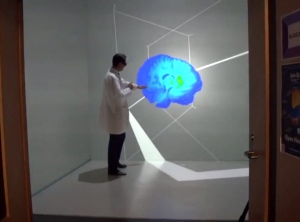Why Migraine Attacks may make you withdraw Into Darkness (or, Your Brain on the Holodeck)
Migraine attacks often come with a number of unwanted symptoms besides just pain. While some types of headaches may just be annoying, or others may make you want to pace the room, migraine patients generally retreat into darkness. And sometimes a migraine attack warning signal is – yawning! Why is that?
In a small study (Dopamine D2/D3 imbalance during migraine attack and allodynia in vivo), researchers at the University of Michigan discovered that, for these patients, dopamine levels fell during the attack itself.
A little background. These 8 patients had episodic types of migraine, and their brains were scanned both during the migraine attack and in between attacks. During the attack, researchers elicited an allodynia experience (sensitive, painful skin. See so that they could also see changes in dopamine levels when this symptom was present).
Dopamine molecules have a lot of functions in the body, such as influencing movement. But they’re most famous for the way they can make you “feel good” – motivating you to do certain things; rewarding and reinforcing behaviour.
The migraine patients had pretty normal levels of dopamine in between attacks – but when an attack hit, levels dropped.
So when dopamine levels crash, what happens? Well, you can guess. This may partly explain why you want to withdraw, get into a dark room, and stay still (although the pain may keep you moving). And the longer you’ve suffered from migraine, the worse your body seems to get at keeping your dopamine levels up where they should be.
Researchers also discovered that the dopamine levels fluctuated during the attack. When the patients felt the sensitive pain of allodynia, dopamine levels rose – but not back to normal levels. Unfortunately, this probably wouldn’t help you “feel better” – the partial rise would only be a reaction, possibly causing more symptoms, such as nausea.
Changing dopamine levels may actually be telling your body something valid – as Dr. Alexandre DaSilva (one of the researchers) put it: “This dopamine reduction and fluctuation during the migraine attack is your brain telling you that something is not going well internally, and that you need time to heal by forcing you to slow down, go to a dark room and avoid any kind of stimulation.”
In the emergency room, patients are sometimes given dopamine antagonists such as metoclopramide to help stop the wild fluctuations (and stop nausea).
Also, magnesium (taken to prevent migraine, but also given intravenously in emergency) may help keep levels stable.
(By the way – one of the topics of this year’s World Migraine Summit will be Calming the Hypersensitive Migraine Brain with Dr. Todd Schwedt of The Mayo Clinic)
The connection between migraine and dopamine levels isn’t a new discovery. What is new is the increasing ability to accurately see how levels rise and fall.
 And that brings us to the fun part of the study.
And that brings us to the fun part of the study.
Here you can see Dr. DaSilva with a floating brain on his “holodeck”. Ok, it’s not exactly a holodeck, but it is an amazing way to see a brain – in this case a collection of responses from a number of brains – in 3D. It’s an incredible way to investigate the results of studies like this one.
For more information, and to see a video of Dr. DaSilva using the 3D brain, check out Brain scans show dopamine levels fall during migraine attacks.
via: Why Migraines Make You Tired and Sad: New Research Points to Role of Dopamine
